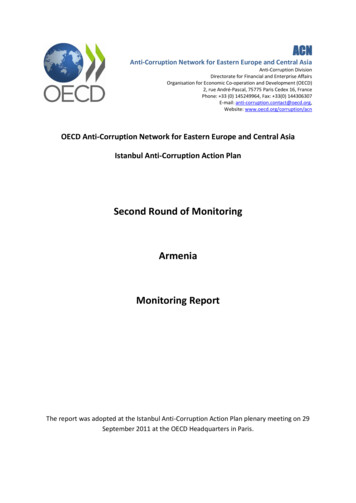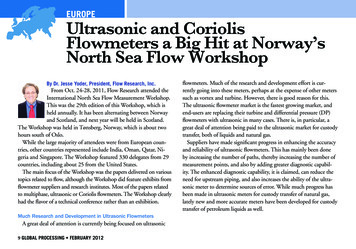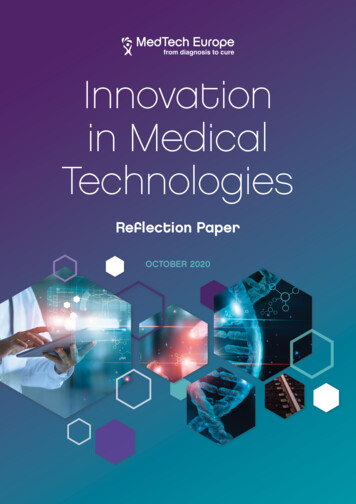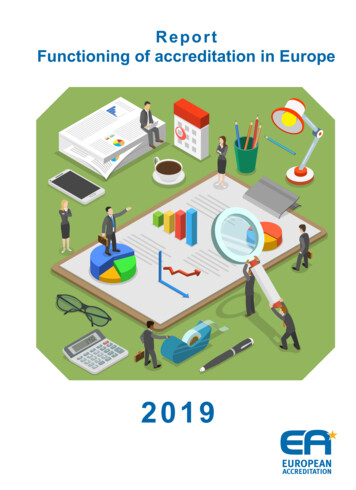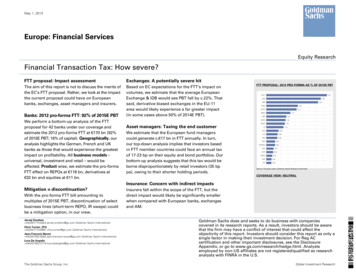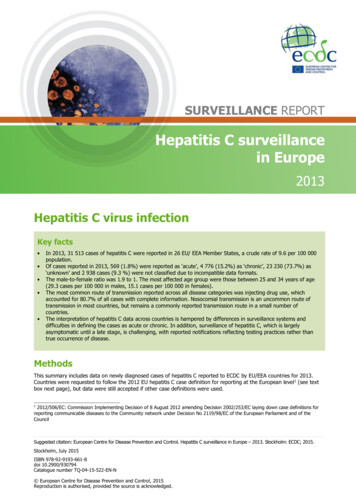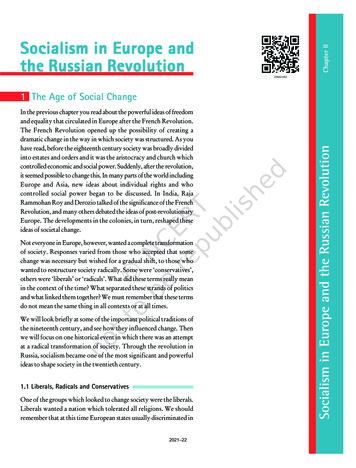
Transcription
Chapter IISocialism in Europe andthe Russian Revolution1 The Age of Social ChangeSocialisminthe RussianEuropeSocialism in Europe andRevolution and the Russian RevolutionIn the previous chapter you read about the powerful ideas of freedomand equality that circulated in Europe after the French Revolution.The French Revolution opened up the possibility of creating adramatic change in the way in which society was structured. As youhave read, before the eighteenth century society was broadly dividedinto estates and orders and it was the aristocracy and church whichcontrolled economic and social power. Suddenly, after the revolution,it seemed possible to change this. In many parts of the world includingEurope and Asia, new ideas about individual rights and whocontrolled social power began to be discussed. In India, RajaRammohan Roy and Derozio talked of the significance of the FrenchRevolution, and many others debated the ideas of post-revolutionaryEurope. The developments in the colonies, in turn, reshaped theseideas of societal change.Not everyone in Europe, however, wanted a complete transformationof society. Responses varied from those who accepted that somechange was necessary but wished for a gradual shift, to those whowanted to restructure society radically. Some were ‘conservatives’,others were ‘liberals’ or ‘radicals’. What did these terms really meanin the context of the time? What separated these strands of politicsand what linked them together? We must remember that these termsdo not mean the same thing in all contexts or at all times.We will look briefly at some of the important political traditions ofthe nineteenth century, and see how they influenced change. Thenwe will focus on one historical event in which there was an attemptat a radical transformation of society. Through the revolution inRussia, socialism became one of the most significant and powerfulideas to shape society in the twentieth century.1.1 Liberals, Radicals and ConservativesOne of the groups which looked to change society were the liberals.Liberals wanted a nation which tolerated all religions. We shouldremember that at this time European states usually discriminated in2021–2225
favour of one religion or another (Britain favoured the Church ofEngland, Austria and Spain favoured the Catholic Church). Liberalsalso opposed the uncontrolled power of dynastic rulers. They wantedto safeguard the rights of individuals against governments. Theyargued for a representative, elected parliamentary government, subjectto laws interpreted by a well-trained judiciary that was independentof rulers and officials. However, they were not ‘democrats’. Theydid not believe in universal adult franchise, that is, the right of everycitizen to vote. They felt men of property mainly should have thevote. They also did not want the vote for women.In contrast, radicals wanted a nation in which government was basedon the majority of a country’s population. Many supported women’ssuffragette movements. Unlike liberals, they opposed the privilegesof great landowners and wealthy factory owners. They were notagainst the existence of private property but disliked concentrationof property in the hands of a few.Conservatives were opposed to radicals and liberals. After the FrenchRevolution, however, even conservatives had opened their minds tothe need for change. Earlier, in the eighteenth century, conservativeshad been generally opposed to the idea of change. By the nineteenthcentury, they accepted that some change was inevitable but believedthat the past had to be respected and change had to be brought aboutthrough a slow process.India and the Contemporary WorldSuch differing ideas about societal change clashed during the socialand political turmoil that followed the French Revolution. Thevarious attempts at revolution and national transformation in thenineteenth century helped define both the limits and potential ofthese political tendencies.1.2 Industrial Society and Social ChangeThese political trends were signs of a new time. It was a time ofprofound social and economic changes. It was a time when new citiescame up and new industrialised regions developed, railways expandedand the Industrial Revolution occurred.Industrialisation brought men, women and children to factories. Workhours were often long and wages were poor. Unemployment wascommon, particularly during times of low demand for industrial goods.Housing and sanitation were problems since towns were growingrapidly. Liberals and radicals searched for solutions to these issues.262021–22New wordsSuffragette movement – A movement togive women the right to vote.
Fig.1 – The London poor in the mid-nineteenth century as seen by acontemporary.From: Henry Mayhew, London Labour and the London Poor, 1861.Socialism in Europe and the Russian RevolutionAlmost all industries were the property of individuals. Liberals andradicals themselves were often property owners and employers.Having made their wealth through trade or industrial ventures, theyfelt that such effort should be encouraged – that its benefits wouldbe achieved if the workforce in the economy was healthy and citizenswere educated. Opposed to the privileges the old aristocracy had bybirth, they firmly believed in the value of individual effort, labourand enterprise. If freedom of individuals was ensured, if the poorcould labour, and those with capital could operate without restraint,they believed that societies would develop. Many working men andwomen who wanted changes in the world rallied around liberal andradical groups and parties in the early nineteenth century.Some nationalists, liberals and radicals wanted revolutions to put anend to the kind of governments established in Europe in 1815. InFrance, Italy, Germany and Russia, they became revolutionaries andworked to overthrow existing monarchs. Nationalists talked ofrevolutions that would create ‘nations’ where all citizens would have2021–2227
equal rights. After 1815, Giuseppe Mazzini, an Italian nationalist, conspiredwith others to achieve this in Italy. Nationalists elsewhere – including India– read his writings.1.3 The Coming of Socialism to EuropePerhaps one of the most far-reaching visions of how society should bestructured was socialism. By the mid - nineteenth century in Europe, socialismwas a well-known body of ideas that attracted widespread attention.Socialists were against private property, and saw it as the root of all social illsof the time. Why? Individuals owned the property that gave employmentbut the propertied were concerned only with personal gain and not withthe welfare of those who made the property productive. So if society as awhole rather than single individuals controlled property, more attentionwould be paid to collective social interests. Socialists wanted this change andcampaigned for it.How could a society without property operate? What would be the basis ofsocialist society?India and the Contemporary WorldSocialists had different visions of the future. Some believed in the idea ofcooperatives. Robert Owen (1771-1858), a leading English manufacturer,sought to build a cooperative community called New Harmony in Indiana(USA). Other socialists felt that cooperatives could not be built on a widescale only through individual initiative: they demanded that governmentsencourage cooperatives. In France, for instance, Louis Blanc (1813-1882)wanted the government to encourage cooperatives and replace capitalistenterprises. These cooperatives were to be associations of people whoproduced goods together and divided the profits according to the workdone by members.Karl Marx (1818-1883) and Friedrich Engels (1820-1895) added other ideasto this body of arguments. Marx argued that industrial society was ‘capitalist’.Capitalists owned the capital invested in factories, and the profit of capitalistswas produced by workers. The conditions of workers could not improveas long as this profit was accumulated by private capitalists. Workers had tooverthrow capitalism and the rule of private property. Marx believed thatto free themselves from capitalist exploitation, workers had to construct aradically socialist society where all property was socially controlled. Thiswould be a communist society. He was convinced that workers wouldtriumph in their conflict with capitalists. A communist society was the naturalsociety of the future.282021–22ActivityList two differences between the capitalistand socialist ideas of private property.
1.4 Support for SocialismWorkers in England and Germany began forming associations tofight for better living and working conditions. They set up funds tohelp members in times of distress and demanded a reduction of workinghours and the right to vote. In Germany, these associations worked closelywith the Social Democratic Party (SPD) and helped it win parliamentaryseats. By 1905, socialists and trade unionists formed a Labour Party inBritain and a Socialist Party in France. However, till 1914, socialists neversucceeded in forming a government in Europe. Represented by strongfigures in parliamentary politics, their ideas did shape legislation, butgovernments continued to be run by conservatives, liberals and radicals.ActivityImagine that a meeting has been called inyour area to discuss the socialist idea ofdoing away with private property andintroducing collective ownership. Write thespeech you would make at the meeting if youare:Ø a poor labourer working in the fieldsØ a medium-level landownerØ a house ownerSocialism in Europe and the Russian RevolutionBy the 1870s, socialist ideas spread through Europe. To coordinatetheir efforts, socialists formed an international body – namely, theSecond International.Fig.2 – This is a painting of the Paris Commune of 1871 (From Illustrated London News, 1871). It portrays a scene from thepopular uprising in Paris between March and May 1871. This was a period when the town council (commune) of Paris wastaken over by a ‘peoples’ government’ consisting of workers, ordinary people, professionals, political activists and others.The uprising emerged against a background of growing discontent against the policies of the French state. The ‘ParisCommune’ was ultimately crushed by government troops but it was celebrated by Socialists the world over as a prelude to asocialist revolution.The Paris Commune is also popularly remembered for two important legacies: one, for its association withthe workers’ red flag – that was the flag adopted by the communards ( revolutionaries) in Paris; two, for the ‘Marseillaise’,originally written as a war song in 1792, it became a symbol of the Commune and of the struggle for liberty.2021–2229
2 The Russian RevolutionIn one of the least industrialised of European states this situation wasreversed. Socialists took over the government in Russia through theOctober Revolution of 1917. The fall of monarchy in February 1917and the events of October are normally called the Russian Revolution.How did this come about? What were the social and politicalconditions in Russia when the revolution occurred? To answer thesequestions, let us look at Russia a few years before the revolution.2.1 The Russian Empire in 1914Fig.3 – Tsar Nicholas II in the WhiteHall of the Winter Palace,St Petersburg, 1900.Painted by Earnest Lipgart (1847-1932)India and the Contemporary WorldIn 1914, Tsar Nicholas II ruled Russia and its empire. Besides theterritory around Moscow, the Russian empire included current-dayFinland, Latvia, Lithuania, Estonia, parts of Poland, Ukraine andBelarus. It stretched to the Pacific and comprised today’s CentralAsian states, as well as Georgia, Armenia and Azerbaijan. The majorityreligion was Russian Orthodox Christianity – which had grown outof the Greek Orthodox Church – but the empire also includedCatholics, Protestants, Muslims and Buddhists.Fig.4 – Europe in 1914.The map shows the Russian empire and the European countries at war during the FirstWorld War.302021–22
2.2 Economy and SocietyAt the beginning of the twentieth century, the vast majority ofRussia’s people were agriculturists. About 85 per cent of the Russianempire’s population earned their living from agriculture. Thisproportion was higher than in most European countries. For instance,in France and Germany the proportion was between 40 per cent and50 per cent. In the empire, cultivators produced for the market aswell as for their own needs and Russia was a major exporter of grain.Industry was found in pockets. Prominent industrial areas wereSt Petersburg and Moscow. Craftsmen undertook much of theproduction, but large factories existed alongside craft workshops.Many factories were set up in the 1890s, when Russia’s railwaynetwork was extended, and foreign investment in industry increased.Coal production doubled and iron and steel output quadrupled. Bythe 1900s, in some areas factory workers and craftsmen were almostequal in number.Fig.5 – Unemployed peasants in pre-warSt Petersburg.Many survived by eating at charitablekitchens and living in poorhouses.Workers were a divided social group. Some had strong links withthe villages from which they came. Others had settled in citiespermanently. Workers were divided by skill. A metalworker of St.Petersburg recalled, ‘Metalworkers considered themselves aristocratsamong other workers. Their occupations demanded more trainingand skill . . . ’ Women made up 31 per cent of the factory labourforce by 1914, but they were paid less than men (between half andthree-quarters of a man’s wage). Divisions among workers showedthemselves in dress and manners too. Some workers formedassociations to help members in times of unemployment or financialhardship but such associations were few.Socialism in Europe and the Russian RevolutionMost industry was the private property of industrialists. Governmentsupervised large factories to ensure minimum wages and limited hoursof work. But factory inspectors could not prevent rules being broken.In craft units and small workshops, the working day was sometimes15 hours, compared with 10 or 12 hours in factories. Accommodationvaried from rooms to dormitories.Fig.6 – Workers sleeping in bunkers in adormitory in pre-revolutionary Russia.They slept in shifts and could not keep theirfamilies with them.Despite divisions, workers did unite to strike work (stop work) whenthey disagreed with employers about dismissals or work conditions.These strikes took place frequently in the textile industry during1896-1897, and in the metal industry during 1902.In the countryside, peasants cultivated most of the land. But thenobility, the crown and the Orthodox Church owned largeproperties. Like workers, peasants too were divided. They were also2021–2231
deeply religious. But except in a few cases they had no respect for thenobility. Nobles got their power and position through their servicesto the Tsar, not through local popularity. This was unlike Francewhere, during the French Revolution in Brittany, peasants respectednobles and fought for them. In Russia, peasants wanted the land ofthe nobles to be given to them. Frequently, they refused to pay rentand even murdered landlords. In 1902, this occurred on a large scalein south Russia. And in 1905, such incidents took place allover Russia.Russian peasants were different from other European peasants inanother way. They pooled their land together periodically and theircommune (mir) divided it according to the needs of individual families.2.3 Socialism in RussiaIndia and the Contemporary WorldAll political parties were illegal in Russia before 1914. The RussianSocial Democratic Workers Party was founded in 1898 by socialistswho respected Marx’s ideas. However, because of governmentpolicing, it had to operate as an illegal organisation. It set up anewspaper, mobilised workers and organised strikes.Some Russian socialists felt that the Russian peasant custom of dividingland periodically made them natural socialists. So peasants, notworkers, would be the main force of the revolution, and Russia couldbecome socialist more quickly than other countries. Socialists wereactive in the countryside through the late nineteenth century. Theyformed the Socialist Revolutionary Party in 1900. This party struggledfor peasants’ rights and demanded that land belonging to nobles betransferred to peasants. Social Democrats disagreed with SocialistRevolutionaries about peasants. Lenin felt that peasants were notone united group. Some were poor and others rich, some worked aslabourers while others were capitalists who employed workers. Giventhis ‘differentiation’ within them, they could not all be part of asocialist movement.The party was divided over the strategy of organisation. VladimirLenin (who led the Bolshevik group) thought that in a repressivesociety like Tsarist Russia the party should be disciplined and shouldcontrol the number and quality of its members. Others (Mensheviks)thought that the party should be open to all (as in Germany).2.4 A Turbulent Time: The 1905 RevolutionRussia was an autocracy. Unlike other European rulers, even at thebeginning of the twentieth century, the Tsar was not subject to322021–22Source AAlexander Shlyapnikov, a socialistworker of the time, gives us a descriptionof how the meetings were organised:‘Propaganda was done in the plants andshops on an individual basis. There werealso discussion circles Legal meetingstook place on matters concerning [officialissues], but this activity was skilfullyintegrated into the general struggle forthe liberation of the working class. Illegalmeetings were arranged on the spurof the moment but in an organised wayduring lunch, in evening break, in frontof the exit, in the yard or, inestablishments with several floors, onthe stairs. The most alert workers wouldform a “plug” in the doorway, and thewhole mass piled up in the exit. Anagitator would get up right there on thespot. Management would contact thepolice on the telephone, but thespeeches would have already beenmade and the necessary decision takenby the time they arrived .’Alexander Shlyapnikov, On the Eve of1917.ReminiscencesfromtheRevolutionary Underground.
parliament. Liberals in Russia campaigned to end this state of affairs.Together with the Social Democrats and Socialist Revolutionaries,they worked with peasants and workers during the revolution of1905 to demand a constitution. They were supported in the empireby nationalists (in Poland for instance) and in Muslim-dominatedareas by jadidists who wanted modernised Islam to lead their societies.The year 1904 was a particularly bad one for Russian workers. Pricesof essential goods rose so quickly that real wages declined by 20 percent. The membership of workers’ associations rose dramatically.When four members of the Assembly of Russian Workers, whichhad been formed in 1904, were dismissed at the Putilov Iron Works,there was a call for industrial action. Over the next few days over110,000 workers in St Petersburg went on strike demanding areduction in the working day to eight hours, an increase in wagesand improvement in working conditions.During the 1905 Revolution, the Tsar allowed the creation of anelected consultative Parliament or Duma. For a brief while duringthe revolution, there existed a large number of trade unions andfactory committees made up of factory workers. After 1905, mostcommittees and unions worked unofficially, since they were declaredillegal. Severe restrictions were placed on political activity. The Tsardismissed the first Duma within 75 days and the re-elected secondDuma within three months. He did not want any questioning of hisauthority or any reduction in his power. He changed the votinglaws and packed the third Duma with conservative politicians. Liberalsand revolutionaries were kept out.ActivityWhy were there revolutionary disturbances inRussia in 1905? What were the demands ofrevolutionaries?New words2.5 The First World War and the Russian EmpireIn 1914, war broke out between two European alliances – Germany,Austria and Turkey (the Central powers) and France, Britain andRussia (later Italy and Romania). Each country had a global empire2021–22Jadidists – Muslim reformers within theRussian empireReal wage – Reflects the quantities ofgoods which the wages will actually buy.33Socialism in Europe and the Russian RevolutionWhen the procession of workers led by Father Gapon reached theWinter Palace it was attacked by the police and the Cossacks. Over100 workers were killed and about 300 wounded. The incident,known as Bloody Sunday, started a series of events that became knownas the 1905 Revolution. Strikes took place all over the country anduniversities closed down when student bodies staged walkouts,complaining about the lack of civil liberties. Lawyers, doctors,engineers and other middle-class workers established the Union ofUnions and demanded a constituent assembly.
and the war was fought outside Europe as well asin Europe. This was the First World War.In Russia, the war was initially popular and peoplerallied around Tsar Nicholas II. As the warcontinued, though, the Tsar refused to consult themain parties in the Duma. Support wore thin. AntiGerman sentiments ran high, as can be seen in therenaming of St Petersburg – a German name – asPetrograd. The Tsarina Alexandra’s Germanorigins and poor advisers, especially a monk calledRasputin, made the autocracy unpopular.India and the Contemporary WorldThe First World War on the ‘eastern front’ differedfrom that on the ‘western front’. In the west, armiesfought from trenches stretched along easternFrance. In the east, armies moved a good deal andfought battles leaving large casualties. Defeats wereshocking and demoralising. Russia’s armies lostbadly in Germany and Austria between 1914 and1916. There were over 7 million casualties by 1917.As they retreated, the Russian army destroyedcrops and buildings to prevent the enemy frombeing able to live off the land. The destruction ofcrops and buildings led to over 3 million refugees in Russia. Thesituation discredited the government and the Tsar. Soldiers did notwish to fight such a war.The war also had a severe impact on industry. Russia’s own industrieswere few in number and the country was cut off from other suppliersof industrial goods by German control of the Baltic Sea. Industrialequipment disintegrated more rapidly in Russia than elsewhere inEurope. By 1916, railway lines began to break down. Able-bodiedmen were called up to the war. As a result, there were labour shortagesand small workshops producing essentials were shut down. Largesupplies of grain were sent to feed the army. For the people in thecities, bread and flour became scarce. By the winter of 1916, riots atbread shops were common.342021–22Fig.7 – Russian soldiers during the FirstWorld War.The Imperial Russian army came to be knownas the ‘Russian steam roller’. It was thelargest armed force in the world. When thisarmy shifted its loyalty and began supportingthe revolutionaries, Tsarist power collapsed.ActivityThe year is 1916. You are a general in theTsar’s army on the eastern front. You arewriting a report for the government inMoscow. In your report suggest what youthink the government should do to improvethe situation.
3 The February Revolution in PetrogradIn the winter of 1917, conditions in the capital, Petrograd, were grim.The layout of the city seemed to emphasise the divisions among itspeople. The workers’ quarters and factories were located on the rightbank of the River Neva. On the left bank were the fashionable areas,the Winter Palace, and official buildings, including the palace wherethe Duma met. In February 1917, food shortages were deeply felt inthe workers’ quarters. The winter was very cold – there had beenexceptional frost and heavy snow. Parliamentarians wishing topreserve elected government, were opposed to the Tsar’s desire to dissolvethe Duma.On Sunday, 25 February, the governmentsuspended the Duma. Politicians spoke out againstthe measure. Demonstrators returned in force tothe streets of the left bank on the 26th. On the27th, the Police Headquarters were ransacked. Thestreets thronged with people raising slogans aboutbread, wages, better hours and democracy. Thegovernment tried to control the situation andcalled out the cavalry once again. However, thecavalry refused to fire on the demonstrators. Anofficer was shot at the barracks of a regiment andthree other regiments mutinied, voting to join thestriking workers. By that evening, soldiers andSocialism in Europe and the Russian RevolutionOn 22 Febr uar y, a lockout took place at afactory on the right bank. The next day, workersin fifty factories called a strike in sympathy.In many factories, women led the way to strikes.This came to be called the International Women’sDay. Demonstrating workers crossed from thefactory quarters to the centre of the capital – theNevskii Prospekt. At this stage, no political partywas actively organising the movement. As thefashionable quarters and official buildings weresurrounded by workers, the government imposeda curfew. Demonstrators dispersed by the evening,but they came back on the 24th and 25th. Thegovernment called out the cavalry and police tokeep an eye on them.Fig.8 – The Petrograd Soviet meeting in the Duma, February 1917.2021–2235
striking workers had gathered to form a ‘soviet’ or ‘council’ in thesame building as the Duma met. This was the Petrograd Soviet.The very next day, a delegation went to see the Tsar. Militarycommanders advised him to abdicate. He followed their advice andabdicated on 2 March. Soviet leaders and Duma leaders formed aProvisional Government to run the country. Russia’s future wouldbe decided by a constituent assembly, elected on the basis of universaladult suffrage. Petrograd had led the February Revolution thatbrought down the monarchy in February 1917.Box 1Women in the February Revolution‘Women workers, often . inspired their male co-workers At the Lorenz telephonefactory, Marfa Vasileva almost single handedly called a successful strike. Already thatmorning, in celebration of Women’s Day, women workers had presented red bows to themen Then Marfa Vasileva, a milling machine operator stopped work and declared animpromptu strike. The workers on the floor were ready to support her The foremaninformed the management and sent her a loaf of bread. She took the bread but refused togo back to work. The administrator asked her again why she refused to work and shereplied, “I cannot be the only one who is satiated when others are hungry”. Womenworkers from another section of the factory gathered around Marfa in support andgradually all the other women ceased working. Soon the men downed their tools as welland the entire crowd rushed onto the street.’From: Choi Chatterji, Celebrating Women (2002).India and the Contemporary World3.1 After FebruaryArmy officials, landowners and industrialists were influential inthe Provisional Government. But the liberals as well as socialistsamong them worked towards an elected government. Restrictionson public meetings and associations were removed. ‘Soviets’, likethe Petrograd Soviet, were set up everywhere, though no commonsystem of election was followed.In April 1917, the Bolshevik leader Vladimir Lenin returned toRussia from his exile. He and the Bolsheviks had opposed the warsince 1914. Now he felt it was time for soviets to take over power.He declared that the war be brought to a close, land be transferredto the peasants, and banks be nationalised. These three demandswere Lenin’s ‘April Theses’. He also argued that the Bolshevik Partyrename itself the Communist Party to indicate its new radical aims.Most others in the Bolshevik Party were initially surprised by theApril Theses. They thought that the time was not yet ripe for a362021–22ActivityLook again at Source A and Box 1.Ø List five changes in the mood of theworkers.Ø Place yourself in the position of a womanwho has seen both situations and writean account of what has changed.
socialist revolution and the Provisional Government needed to besupported. But the developments of the subsequent months changedtheir attitude.Through the summer the workers’ movement spread. In industrialareas, factory committees were formed which began questioningthe way industrialists ran their factories. Trade unions grew innumber. Soldiers’ committees were formed in the army. In June,about 500 Soviets sent representatives to an All Russian Congressof Soviets. As the Provisional Government saw its power reduceand Bolshevik influence grow, it decided to take stern measuresagainst the spreading discontent. It resisted attempts by workersto run factories and began arresting leaders. Populardemonstrations staged by the Bolsheviks in July 1917 were sternlyrepressed. Many Bolshevik leaders had to go into hiding or flee.Fig.9 – A Bolshevik image of Leninaddressing workers in April 1917.Socialism in Europe and the Russian RevolutionMeanwhile in the countryside, peasants and their SocialistRevolutionary leaders pressed for a redistribution of land. Landcommittees were formed to handle this. Encouraged by theSocialist Revolutionaries, peasants seized land between July andSeptember 1917.Fig.10 – The July Days. A pro-Bolshevik demonstration on 17 July 1917 being fired upon by the army.2021–2237
3.2 The Revolution of October 1917Box 2As the conflict between the Provisional Government and theBolsheviks grew, Lenin feared the Provisional Government wouldset up a dictatorship. In September, he began discussions for anuprising against the government. Bolshevik supporters in the army,soviets and factories were brought together.On 16 October 1917, Lenin persuaded the Petrograd Soviet andthe Bolshevik Party to agree to a socialist seizure of power. AMilitary Revolutionary Committee was appointed by the Sovietunder Leon Trotskii to organise the seizure. The date of the eventwas kept a secr
Socialism in Europe and the Russian Revolution 27 Almost all industries were the property of individuals. Liberals and radi

